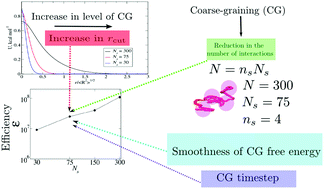Coarse-graining simulation approaches for polymer melts: the effect of potential range on computational efficiency
Abstract
The integral equation coarse-graining (IECG) approach is a promising high-level coarse-graining (CG) method for polymer melts, with variable resolution from soft spheres to multi CG sites, which preserves the structural and thermodynamical consistencies with the related atomistic simulations. When compared to the atomistic description, the procedure of coarse-graining results in smoother free energy surfaces, longer-ranged potentials, a decrease in the number of interaction sites for a given polymer, and more. Because these changes have competing effects on the computational efficiency of the CG model, care needs to be taken when studying the effect of coarse-graining on the computational speed-up in CG molecular dynamics simulations. For instance, treatment of long-range CG interactions requires the selection of cutoff distances that include the attractive part of the effective CG potential and force. In particular, we show how the complex nature of the range and curvature of the effective CG potential, the selection of a suitable CG timestep, the choice of the cutoff distance, the molecular dynamics algorithms, and the smoothness of the CG free energy surface affect the efficiency of IECG simulations. By direct comparison with the atomistic simulations of relatively short chain polymer melts, we find that the overall computational efficiency is highest for the highest level of CG (soft spheres), with an overall improvement of the computational efficiency being about 106–108 for various CG levels/resolutions. Therefore, the IECG method can have important applications in molecular dynamics simulations of polymeric systems. Finally, making use of the standard spatial decomposition algorithm, the parallel scalability of the IECG simulations for various levels of CG is presented. Optimal parallel scaling is observed for a reasonably large number of processors. Although this study is performed using the IECG approach, its results on the relation between the level of CG and the computational efficiency are general and apply to any properly-constructed CG model.



 Please wait while we load your content...
Please wait while we load your content...
